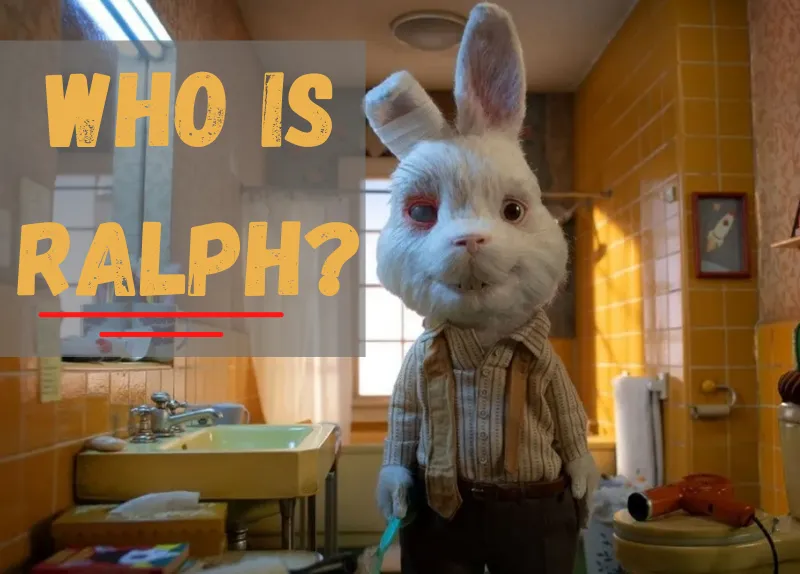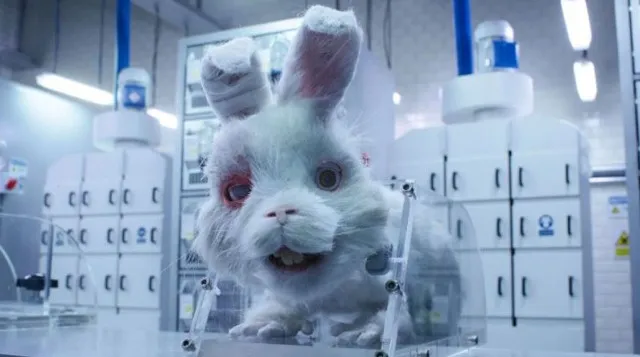
El pasado 6 de abril un cortometraje se hizo viral en las redes sociales, donde nos muestran a un conejo animado siendo entrevistado para explicar como es la vida de un animal de laboratorio.
Es un cortometraje muy fuerte de observar a pesar de ser animado.
Ralph nos muestra todas las crueldades que pueden llegar a realizar en su "trabajo" para poder comprobar la seguridad de ciertos cosméticos y aprobar su uso en los Humanos. Él nos explica el por qué de cada una de las lesiones que tiene en su cuerpo, como es vivir con ellas y el dolor que le genera. A pesar de todo esto, él intenta verlo de una manera positiva (aunque claramente no lo sea) y creo que esa ironía fue la que mayor impacto generó en la audiencia e hizo que se volviera viral.
Last April 6th a short film went viral on social networks, where they show us an animated rabbit being interviewed to explain how is the life of a laboratory animal.
It is a very strong short film to watch despite being animated.
Ralph shows us all the cruelties they can go through in their "work" in order to test the safety of certain cosmetics and approve their use on Humans. He explains why each of the injuries he has on his body, what it's like to live with them, and the pain it causes him. Despite all this, he tries to see it in a positive way (although clearly, it is not) and I think that irony was the one that generated the greatest impact on the audience and made it go viral.
En este cortometraje producido por Humane Society International participaron las voces de artistas como Taika Waititi, Ricky Gervais, Zac Efron, Olivia Munn y más. Todos a favor de eliminar por completo el uso de animales como conejillos de india para testear los cosméticos.
This short film produced by Humane Society International featured the voices of artists such as Taika Waititi, Ricky Gervais, Zac Efron, Olivia Munn, and more all in favor of completely eliminating the use of animals as guinea pigs for cosmetics testing.
Why Industries use Animal Testing? | ¿Por qué las Industrias realizan Pruebas en Animales?
Para que un producto pueda tener la aprobación de su uso en Humanos, necesitan poder demostrar su seguridad y que no generará ningún efecto adverso, o por lo menos en más de un 95%. A raíz de esto, desde hace muchos años atrás se realizan experimentos en diferentes especies de animales para poder obtener esta aprobación y salir posteriormente al mercado.
La variedad de productos y materiales responsables de que se realicen estas pruebas son mucho mayores de lo que pensamos, la mayoría de ellos son cosméticos como:
- Shampoo
- Maquillaje
- Lociones para el cabello
- Gotas para los ojos
- Jabones
- Protector solar
Sin embargo, esta realidad no solo cubre a los productos cosméticos sino también a medicamentos y demás productos farmacéuticos, donde varios químicos, principios activos y dosis letales se administran en estos Animales de Prueba para estudiar los resultados y seguir con los avances médicos y científicos, todo para que sea seguro para el uso Humano (y en este caso, para la medicina veterinaria también)
In order for a product to be approved for use in humans, it must be able to demonstrate its safety and that it will not generate any adverse effects, or at least not more than 95%. As a result, for many years now, experiments have been carried out on different species of animals in order to obtain this approval and then go to the market.
The variety of products and materials responsible for these tests are much greater than we think, most of them are cosmetics such as:
- Shampoo
- Make-up
- Hair lotions
- Eye drops
- Soaps
- Sunscreen
However, this reality not only covers cosmetic products but also drugs and other pharmaceutical products, where various chemicals, active ingredients, and lethal doses are administered in these Test Animals to study the results and follow medical and scientific advances, all to make it safe for human use (and in this case, for veterinary medicine as well).

Are there less cruel alternatives? | ¿Existen alterativas menos crueles?
Desde hace unos años hasta la actualidad se han estado investigando alternativas para no tener que realizar pruebas en animales vivos. A diferencias de antes, la tecnología ha avanzado demasiado, ha avanzado hasta un punto donde se puede trabajar molecularmente para ver y modificar los efectos de ciertas sustancias.
Si bien existen mas de 50 alternativas diferentes para testear estos productos, la gran mayoría sigue en período de prueba para ser completamente verás. A pesar que ciertas páginas alegan que son 100% funcionales otras dicen totalmente lo contrario, así que es muy difícil ser conciso en este punto.
Sin embargo, entre esas alternativas que mencionan se encuentran el uso de una piel artificial muy parecida a la Humana para probar cosméticos, Pruebas in vitro, el uso de los ojos de vacas o pollos que ya han sido sacrificados para la industria de la carne para testear compuestos que puedan ser irritantes para los ojos, etc. Hasta el mismo uso de voluntarios (Humanos) es considerado una alternativa.
For some years now, alternatives have been investigated to avoid having to test on live animals. Unlike before, technology has advanced to a point where it is possible to work molecularly to see and modify the effects of certain substances.
Although there are more than 50 different alternatives for testing these products, most of them are still in the testing period to be completely verified. Although certain pages claim that they are 100% functional, others say totally the opposite, so it is very difficult to be concise on this point.
However, among those alternatives they mention are the use of artificial skin very similar to human skin to test cosmetics, in vitro tests, the use of the eyes of cows or chickens that have already been slaughtered for the meat industry to test compounds that could be irritating to the eyes, etc. Even the use of volunteers (humans) is considered an alternative.
Are animal tests still being conducted? | ¿Se siguen realizando pruebas en animales?
Estados Unidos y muchos países de Europa penalizan cualquier sufrimiento animal y no exigen que los productos sean probados en ellos para afirmar su seguridad. Además, de tantos estudios que se hicieron en el pasado, ya se sabe que materiales son seguros para los Humanos.
En China, entrará en vigencia una ley en mayo del 2021 que permitirá a las empresas vender sus productos importados sin la necesidad de tener que realizar pruebas en animales, sin embargo únicamente esta dirigido a los "cosméticos generales" como lo son shampoo, jabón, lociones, labiales y maquillaje. Mientras qué, esta nueva política no aplicará para los productos que estén dirigidos a niños, aquellos que contengan "nuevos ingredientes" y a los "cosméticos especiales" como lo son el tinte para el cabello, protector solar y productos para la pérdida del cabello.
The United States and many European countries criminalize any animal suffering and do not require products to be tested on them to affirm their safety. In addition, from so many studies that have been done in the past, it is already known which materials are safe for humans.
In China, a law will come into force in May 2021 that will allow companies to sell their imported products without the need to test on animals, however it is only aimed at "general cosmetics" such as shampoo, soap, lotions, lipsticks and makeup. However, this new policy will not apply to products intended for children, those containing new ingredients and "special cosmetics" such as hair dye, sunscreen and hair loss products.
It all comes down to | ¿En qué se resume todo?
Cada vez se realizan menos pruebas en animales y se siguen buscando otras alternativas que hasta pueden llegar a ser más eficaces, sin embargo aún queda un largo camino por recorrer.
Si bien han publicado qué empresas siguen realizando pruebas en animales, prefiero no compartirlas debido a que se ha demostrado que algunas ya llevan años que dejaron de realizarlos, y aún así, siguen en la lista. Por lo tanto, esa parte es mejor que la investiguen por su cuenta.
There are fewer and fewer tests on animals and they continue to look for other alternatives that may even be more effective, but there is still a long way to go.
Although they have published which companies are still testing on animals, I prefer not to share them because it has been shown that some of them have stopped testing on animals years ago, and yet they are still on the list. So, that part is best researched on your own.
